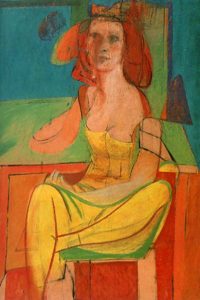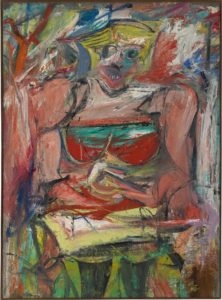
“Seated Woman”
There are many ways to make a painting. Most painters start out with an idea. Maybe they have a model or a landscape in front of them. Maybe they’re making it up. But usually execution is preceded by a plan or a vision.
Willem de Kooning didn’t do it that way. His approach was to just… paint. Jump in blindly.
“What you do when you paint,” he said, “[is] you take a brush full of paint, get paint on the picture, and you have faith.”
Critic Harold Rosenberg coined the term “action painting.” This was the early ‘50s, when a painting style based on absolute freedom fit the American zeitgeist. Rosenberg made it seem heroic, a “gesture of liberation.”
It sounds good, but could a painter really carry on like this for an entire career?
“De Kooning: A Retrospective” is the Museum of Modern Art’s case that he could. They back it with seven decades of evidence — some 200 works — spanning the artist’s Rotterdam youth in the 1920s through his old age in the Hamptons in the 1980s. The De Kooning of MoMA’s show is an iconoclast among abstractionists, an artist who never let himself be tied down by theory or style.
Others in the New York School settled into predictable formats: Jackson Pollock with his swirling skeins, Franz Kline with his blowups of Asian calligraphy, Mark Rothko with his shimmering horizontal bars. De Kooning had his thematic periods – his black-and-white compositions, his “Woman” series, his evocations of the Long Island landscape – but more than any of the others, he stuck with the high-wire act of moment-by-moment improvisation.

“Woman V”
“I paint the way I do because I can keep on putting more and more things in – like drama, pain, anger, love, a figure, a horse, my ideas of space,” he once said. “It doesn’t matter if it differs from mine [my ideas and feelings], as long as it comes from the painting, which has its own integrity and intensity.”
Of course, a viewer is entitled to ask if that is really true? Where does the painting get its own integrity, if not from the artist? Can you build paintings on accidents, on backing yourself into corners then desperately clawing your way out? Unlike Pollock, who was a primitive by nature, the European-born de Kooning was well-grounded in art history and could draw like an old master. To paint this way meant working against his skills.
He made a virtue of being off balance and snatching at fleeting perceptions, once wisecracking that he was “a slipping glimpser.”
Conservative viewers may find a haven amid the figure paintings of the 1940s, in which a conventional model seems half infected with a cubism virus. Heads partially dissolve, limbs are missing, arms defy anatomy. However, the red-haired, blue-eyed subject of “Seated Woman” is still fetching despite the strange lobes in her hair.
At his best, De Kooning worked off two points of tension: cubism’s logical structure and surrealism’s irrational “automatic writing.” The two are in perfect balance in “Excavation” (1950), an 8-foot-wide painting of interlocking shapes in which whitish, vaguely biomorphic forms connect, collide and overlap. Shreds of color poke through the warp and weave. Its restless rhythms suggest jazz music and the energy of New York City.
The golden decade of the ‘50s also produced de Kooning’s notorious “Woman” series. These savage, grinning, balloon-breasted females in slashing brushstrokes are part pinup, part rich matron, and part harpy. There have been cries of “misogyny,” but others have pointed to de Kooning’s Northern European background with its tradition of the grotesque (think Bosch and Bruegel).
In 2006, “Woman III,” which is in the show, became the second-most expensive painting sold at auction when it was knocked down for $137.5 million.

“Untitled” from 1984.
No paintings from subsequent decades have commanded anywhere near that price, which raises the question that haunts de Kooning’s reputation: did his work go downhill beyond the ‘50s? The market seems to say so, but MoMA doesn’t agree, lavishing half the exhibit’s space on those three decades.
DeKooning’s biography points to trouble in those years. Perhaps all that artistic freedom – with its attendant anxiety — took its toll. The ab-ex painters were notorious for drinking and carousing. Several committed suicide and Pollock virtually did, drunkenly ramming his car into a tree. De Kooning was not that self destructive, but by the ‘60s, he was a full-blown alcoholic.
Is it so surprising then, to find slackness in the works from those years? The paintings of the 60s and 70’s no longer have any bones. The centers don’t hold. The surface, once marked with tight, intricate passages as well as sweeping gestural strokes, goes all loose and slippery, as if some watery sea creatures had been laid out to dry on the canvas.
The most questionable works are the late paintings, done between 1981 and 1987, in which the compositions become progressively simpler, culminating in ribbon-like lines that loop across the surface like wisps of smoke. De Kooning had some dementia by this time, and critical opinion has been divided on whether this was the serene culmination of a career or the doodlings of an artist with Alzheimers.
The inability of critics to agree if an abstract expressionist artist still has his wits – points up just how challenging this kind of art can be. It has also depressed the market for the late paintings. That may change, now that MoMA has thrown its considerable weight behind these pictures, acknowledging their increased simplification but finding the same painterly intelligence at work and a poignancy in the very last ones, which the wall text says, “evoke landscapes of wind-blown foliage and swaying figures.”

